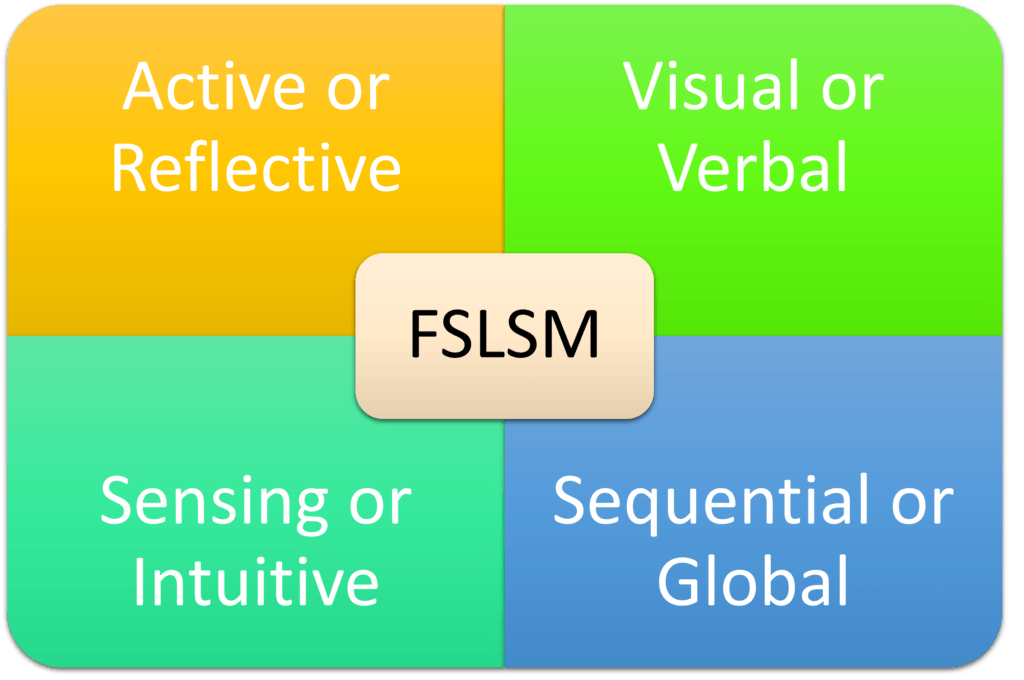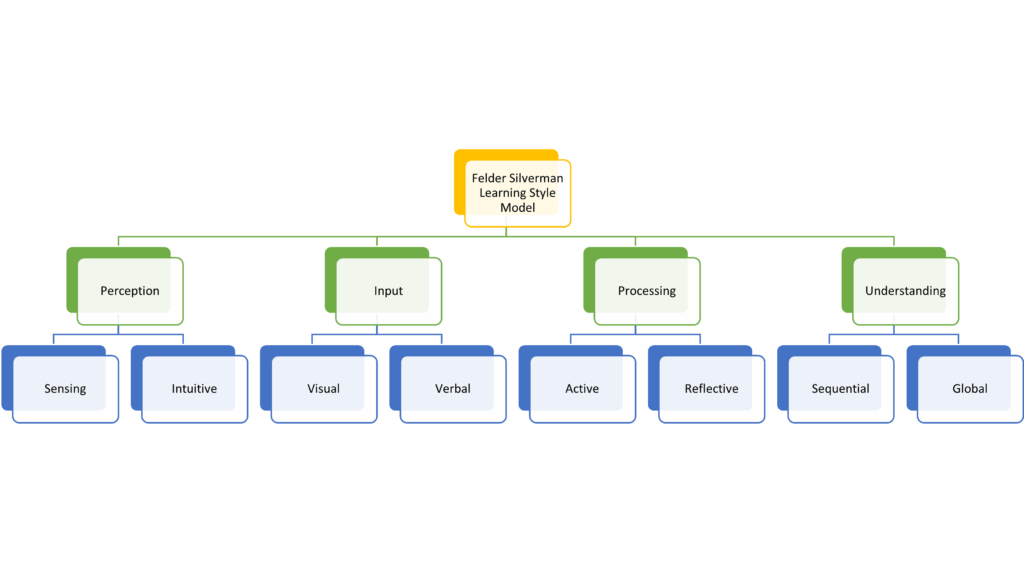Introduction
The Felder Silverman Learning Style Model (FSLSM) was developed by Dr. Richard M. Felder and Dr. Linda K. Silverman in the 1980s and is based on the idea that individuals have different ways of processing information and learning. The model is comprised of four dimensions, each of which represents a continuum of preferences. Individuals can fall anywhere on each continuum and may have a combination of preferences. This is our extensive coverage of 13 Learning Models that you should know as a learning and development manager or an instructional designer.
The Four Dimensions of the Felder Silverman Learning Style Model

Dimension 1: Sensing vs. Intuitive Learning
The first dimension of the Felder Silverman Learning Style Model (FSLSM) is Sensing vs. Intuitive Learning. Sensing learners tend to be more concrete and practical, preferring information that can be directly observed or experienced. Intuitive learners, on the other hand, are more abstract and theoretical, preferring to focus on patterns and connections between ideas.
- Sensing learners prefer concrete, practical information.
- Intuitive learners prefer abstract, theoretical information.
Dimension 2: Visual vs. Verbal Learning
The second dimension is Visual vs. Verbal Learning. Visual learners tend to process information through images and spatial relationships, while verbal learners prefer to process information through words and language.
- Visual learners prefer pictures, diagrams, and other visual aids.
- Verbal learners prefer written and spoken explanations.
Dimension 3: Active vs. Reflective Learning
The third dimension is Active vs. Reflective Learning. Active learners prefer to learn through hands-on experiences and experimentation, while reflective learners prefer to process information internally, through thinking and introspection.
- Active learners prefer hands-on activities and group work.
- Reflective learners prefer to think things through and work independently.
What are Felder’s four dimensions of learning?
The fourth and final dimension is Sequential vs. Global Learning. Sequential learners prefer to learn information in a linear, step-by-step manner, while global learners prefer to see the big picture and understand how individual pieces fit together.
- Sequential learners prefer to learn in a linear, step-by-step manner.
- Global learners prefer to learn in a holistic, big-picture manner.
Remember, it’s important to note that individuals can fall anywhere along each continuum, and may not fit neatly into one category. The Felder Silverman Learning Style Model (FSLSM) provides a framework for understanding and accommodating different learning styles, but it’s essential to approach it with flexibility and an open mind.
History of the Felder Silverman Learning Style Model
The Felder Silverman Learning Style Model (FSLSM) was developed in the 1980s by Richard Felder and Linda Silverman. It was originally designed to help engineering students, but it has since been applied to a wide range of disciplines. The model is based on the idea that individuals have unique preferences for how they learn and process information.
Identifying Your Learning Style through Felder Silverman Learning Style Model
To identify your learning style using the FSLSM, you can take a questionnaire that assesses your preferences on each dimension. The questionnaire typically asks a series of questions related to learning preferences and provides a score for each dimension based on your responses.
Once you have identified your learning style preferences, you can use this information to tailor your learning approach to suit your strengths better. For example, if you are a visual learner, you might benefit from using diagrams or visual aids to help you understand new concepts. If you are an active learner, you might benefit from participating in hands-on activities or group discussions.

| Dimension | Sensing vs. Intuitive Learning | Visual vs. Verbal Learning | Active vs. Reflective Learning | Sequential vs. Global Learning |
| Description | Concrete, practical information | Pictures, diagrams, visual aids | Hands-on activities, group work | Linear, step-by-step learning |
| Sensing Learners | Prefer practical applications | Prefer visual aids | Enjoy hands-on activities | Learn in a step-by-step manner |
| Intuitive Learners | Prefer abstract theories | Prefer written and spoken explanations | Prefer to think things through | Prefer to learn in a big-picture manner |
| Visual Learners | Learn best with visual aids | Prefer pictures and diagrams | Enjoy watching demonstrations | Enjoy flowcharts and diagrams |
| Verbal Learners | Learn best with written/spoken explanations | Prefer to read and listen | Enjoy group discussions | Enjoy written instructions |
| Active Learners | Enjoy hands-on experiences | Prefer group work | Learn through trial and error | Enjoy experimentation |
| Reflective Learners | Enjoy thinking things through | Prefer working independently | Learn through observation | Enjoy analyzing information |
| Sequential Learners | Prefer step-by-step instructions | Prefer linear processes | Like to follow a plan or schedule | Tend to work through problems systematically |
| Global Learners | Prefer big-picture thinking | Prefer holistic approaches | Enjoy brainstorming | Tend to see connections between ideas |
Theories That Inspired the FSLSM
The Felder Silverman Learning Style Model (FSLSM) was influenced by several other learning style models, including Kolb’s Experiential Learning Model and Jung’s Psychological Types. Kolb’s model proposes that learning occurs in a cycle of concrete experience, reflective observation, abstract conceptualization, and active experimentation. Jung’s model suggests that individuals have distinct personality types that influence their preferences for how they learn and process information.
Where Can the Felder Silverman Learning Style Model Be Used?
The Felder Silverman Learning Style Model (FSLSM) can be used in a variety of settings, including education, training, and personal development. Educators can use the model to better understand their student’s learning styles and adjust their teaching methods accordingly. Trainers can use the model to design training programs tailored to their employees’ learning styles. Individuals can use the model to better understand their own learning preferences and identify strategies for maximizing their learning potential.
Using the FSLSM to Improve Learning Outcomes
One of the main benefits of using the Felder Silverman Learning Style Model (FSLSM) is that it can help improve learning outcomes. By identifying your learning style preferences and using strategies that align with those preferences, you can improve your retention and understanding of new information.
For example, if you are a sequential learner, you might benefit from breaking down complex concepts into smaller, more manageable steps. If you are a global learner, you might benefit from taking a more holistic approach to learning, focusing on the big picture before delving into individual details.
Advantages and Disadvantages of Using the FSLSM
One of the main advantages of using the FSLSM is that it provides a framework for understanding and accommodating different learning styles. Educators and trainers can use the model to tailor their instruction to better suit the needs of individual learners.
However, there are also some disadvantages to using the Felder Silverman Learning Style Model (FSLSM). Some critics argue that it oversimplifies the complexity of learning and that it doesn’t account for the fact that individuals can have multiple learning styles. Additionally, some have criticized the model’s reliability and validity
Conclusion
In conclusion, the Felder-Silverman Learning Style Model is useful for identifying individual learning preferences and developing effective learning strategies. By understanding your strengths and weaknesses as a learner, you can tailor your approach to learning and maximize your potential for academic success. The FSLSM is based on the idea that individuals have different ways of processing information and learning. By identifying and leveraging these differences, students can improve their understanding and retention of new information.
It’s important to note that the Felder Silverman Learning Style Model (FSLSM) is just one of many learning style models, and some researchers argue that the concept of learning styles is not supported by scientific evidence. While it’s true that individual learning preferences may not be as clear-cut as the FSLSM suggests, the model can still be a useful tool for students who want to gain a better understanding of their learning style and develop effective study strategies.
Ultimately, the key to success in learning is not just identifying your learning style, but also being flexible and adaptable in your approach to learning. While it’s important to play to your strengths, it’s also essential to challenge yourself and try new things. By incorporating a variety of learning strategies into your study routine, you can expand your skills and improve your overall academic performance.
Samrat is a Delhi-based MBA from the Indian Institute of Management. He is a Strategy, AI, and Marketing Enthusiast and passionately writes about core and emerging topics in Management studies. Reach out to his LinkedIn for a discussion or follow his Quora Page
